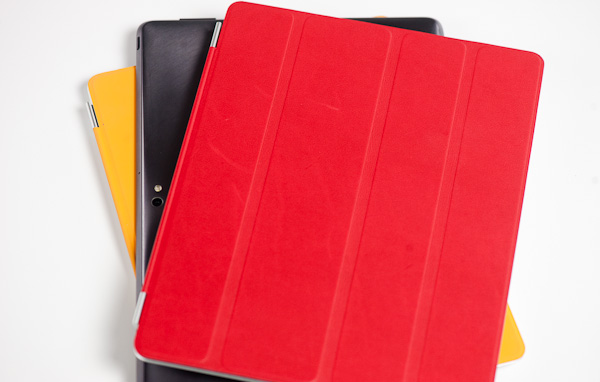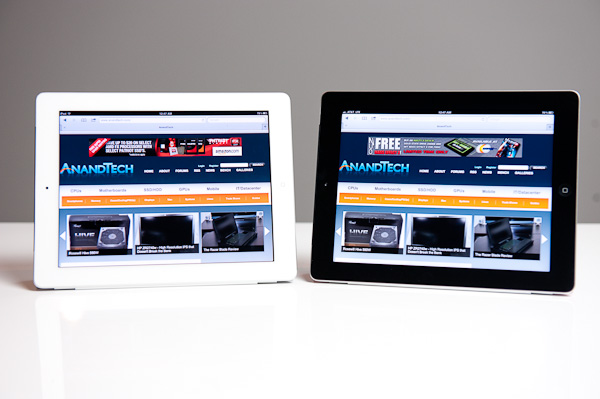The Apple iPad Review (2012)
by Vivek Gowri & Anand Lal Shimpi on March 28, 2012 3:14 PM ESTSince Apple launched the first iPad two years ago, the tablet market has evolved rapidly. While slate tablets were nothing new, the original iPad was the first serious tablet to be built around smartphone components and a user interface designed specifically for touchscreen input. The hardware was enough to run the OS smoothly while maintaining good battery life, the thin and light form factor lent itself to easy portability, and the touch-based user experience was miles better than earlier devices based on desktop operating systems.
We take it for granted now, but this was all news back in 2010, and the iPad was practically in a category of its own, with no real competitors to speak of. After Apple started shipping the iPad, the segment basically exploded—we had Google jump in with Honeycomb, HP got into it (and then out of it) with webOS, RIM had a go with the PlayBook, Amazon pushed the Kindle line into the tablet space, and Microsoft created its next release of Windows with tablets in mind. Along the way, Apple updated the iPad, both on the software side with multitasking, a new notifications system, and a myriad of UI updates, as well as launching second generation iPad hardware. The iPad 2 was a comprehensive update, bringing a dual core processor, unrivaled graphics performance, cameras fore and aft, and a ground up redesign that brought a thinner and lighter form factor.
The iPad 2 was a significant improvement over the original—faster, more portable, and generally a far more polished device. Not that it was perfect: iOS 4 still had issues with smooth multitasking and an archaic notifications system, the cameras were mediocre, and the XGA display, while a great quality panel, didn’t have the kind of pixel density expected of a premium mobile device. The iPad 2 hit market around the same time as Honeycomb (in Motorola’s Xoom) early last year, and at first Apple still held a major edge in terms of hardware. As more impressive Honeycomb devices like Samsung’s Galaxy Tab 10.1 and the ASUS Transformer Prime were launched, along with Ice Cream Sandwich looming on the horizon, Android became a much more viable tablet alternative to iOS. And with Microsoft planning for a major push later this year for ARM-based Windows 8 tablets centered around the Metro UI, Apple has never faced such stiff competition in the tablet space. Which brings us to the third generation of iPad hardware.
It has a display resolution that dwarfs most high-end desktop displays. The panel also puts a real emphasis on quality, not just resolution. For a computing device targeted squarely at the consumer market, both of these things are rarities.
Its SoC is the absolute largest ever squeezed into an ARM based tablet. The chip itself is even bigger than what you find in most mainstream notebooks. It’s expensive, it puts out a ton of heat and it offers a tremendous GPU performance advantage over anything else in its class.
And it has a battery that’s larger than what ships in the current crop of similarly sized ultraportables and Ultrabooks.
The new iPad doesn’t significantly change the tablet usage paradigm, but it does put all previous attempts at building hardware in this space to shame. It’s the sort of no holds barred, performance at any expense design that we’re used to seeing from enthusiast PC component vendors—but in a tablet...from Apple.
Welcome to the new iPad.












234 Comments
View All Comments
zanon - Wednesday, March 28, 2012 - link
In the article:The higher resolution does make smaller fonts readable. For something like an SSH session, that really will mean significantly more stuff can be on a screen at once.
MobiusStrip - Thursday, March 29, 2012 - link
A more useful change would be abandoning the ridiculous glossy screens. It's sad that Apple takes its cues from the plastic schlock being peddled at Best Buy, and participates in this fraud of shoving glossy screens down customers' throats.repoman27 - Thursday, March 29, 2012 - link
The plastic schlock at Best Buy has a glossy plastic film applied to a cheap TN panel. Apple puts a piece of glass in front of their much more expensive IPS panels to protect them. The only way to make that glass (or the glass of the LCD panel itself) matte would be to apply an antiglare plastic film coating to the glass. These films have drawbacks (they block and scatter light making small details and text blurry.) The drawbacks become more exaggerated the farther the front surface of the glass is from the plane of the actual LCD.But you're right, it's probably Apple copying the design language of sub $500 laptops in order to somehow defraud the general public and force their customers to buy the products they actually produce.
And seeing as how this discussion is about the new iPad screen, I'd like to point out that you're complaining about the lack of an antiglare coating on a touchscreen device... Strong work.
Sabresiberian - Thursday, March 29, 2012 - link
How is it fraud? Apple isn't, like, saying their screens are anti-reflective and then giving you totally reflective glossy screens.Many people prefer a glossy screen and simply aren't bothered by background reflections.
;)
Henk Poley - Monday, April 2, 2012 - link
Yes, Apple really should use Schott Conturan/Amiran/Mirogard antireflective technology.btw, not-glossy does not mean matte. Air is not matte either. Glass can be see-through too ;)
Watwatwat - Monday, April 2, 2012 - link
Nope, steve gibson has tested even using screen protectors on the new ipad vs not, it seems to affect the resolution at that level, matte might not be a good idea at all for high density display.KoolAidMan1 - Thursday, March 29, 2012 - link
I wasn't initially blown away, but then after a day of using it every other display seemed bad in comparison. It is one of those things you didn't realize was needed until using it, now I want very high DPI in all of my monitors.menting - Wednesday, March 28, 2012 - link
Is it just me, or do Shadowgun and GTA screenshots look more detailed in Transformer Prime than in the iPad?menting - Wednesday, March 28, 2012 - link
nm..i just noticed that it's scaled up in new ipad, so it's definitely not as sharp.However, how can fps be fairly compared in this case then?
TheJian - Wednesday, March 28, 2012 - link
Basically because of the way Nvidia and Apple approach games so far, you can expect games on Tegra3 to just look better as they seem to aim for more graphics and fewer games (they spend money on fewer projects that produce better results), as opposed to apple who spreads the wealth but just ends up with more cannon fodder if you ask me :) You should get more variety on Apple I'd guess, but a better experience with fewer choices on Tegra3/Android. I like QUALITY over QUANTITY personally and hope Apple leans the way of Nvidia in the future. I would rather have 10 games that I'd play for weeks or months (if I'm playing on my hdtv through one of these I want better water, buildings etc) rather than games I fire up for less than 20 minutes as their just another angry birds variant and arguably useless on your TV.I want these devices to KILL the consoles next year and make MS/Nintendo etc give it up in 2015 or whenever the next revs should come. I hope they just realize we won't buy them anymore. DirectX11 on my phone/tablet and probably standard 25x14 resolutions by then (won't all be retina by 2015?) make a console purchase STUPID. This could be the merging of console/pc we need since phones/tablets rev yearly like pc's instead of 10yr console's stuck in stone stagnating gaming. Your phone as a portable console with xbox/ps3/pc gamepad support would be excellent. Pump it out to a monitor and keyboard/mouse setup and you have a notebook replacement too...LOL Now if they'd just put in a few extra cores by then that will disable if on their own screen but turn on when on a larger display like TV/Monitor and we have exactly what we want in both cases :)
Pipe dreams? Retina is here now, and gamepads sort of. Next stop cores that only turn on depending on display output :) Awesome battery on the road, and great power in the dock at home pushing your 27in monitor. :) The 28nm versions by xmas of everyone's chips should come close to console power or surpass them. Interesting times.